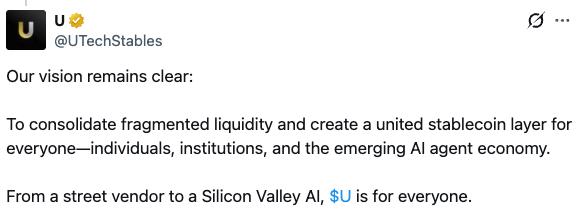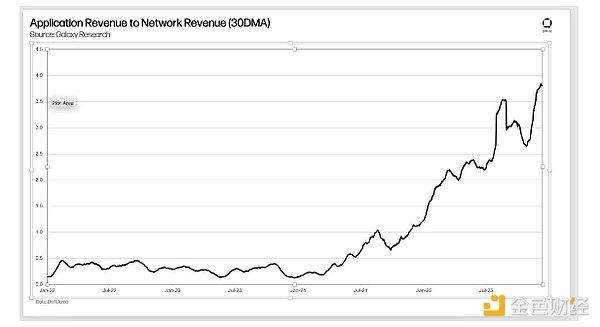Cryptocurrencies are now in a more mature and clearer stage than ever before. While the market still experiences speculative cycles, many areas within the industry have demonstrated product-market fit (PMF) and have practical application value beyond speculation. However, some domains remain in the experimental or problem-solving stage, with unresolved challenges hindering their widespread adoption.
This article will analyze the key drivers behind mass adoption, explore the successful sub-sectors, and discuss the domains still facing significant obstacles.
1. Core Technical Drivers: The Foundation of Cryptocurrency Growth
1) Low-Cost Block Space: L2 and High-Throughput L1
A major breakthrough in the crypto industry has been the significant reduction in transaction costs. The introduction of scalable Layer 2 (L2) Rollup solutions and high-throughput Layer 1 (L1) blockchains has enabled developers to more easily build efficient and user-friendly applications.
L2 scaling solutions - Ethereum Rollup solutions such as , , and
High-throughput L1 alternatives - , , and utilize parallel execution and different decentralization trade-offs to achieve high-speed, low-cost transactions.
Growth drivers: Lower transaction costs have reduced the barriers to entry for developers and users, driving the accelerated adoption of DeFi, gaming, and asset tokenization.
2) Wallet Upgrades and Seamless User Experience (UX)
A major obstacle to cryptocurrency adoption has been the complex onboarding process, but this problem has been greatly improved and will continue to be optimized in the coming months.
Smart contract wallets - Wallets like and have introduced features such as gas-free transactions, self-recovery, multi-signature security, user gas fee sponsorship, and chain abstraction, significantly enhancing the user experience.
Social login and passwordless authentication - With tools like Web3Auth and Privy, users can access their wallets directly through email or phone number, without the need for complex seed phrase management.
Crosschain Intents - Advanced wallets and DApps are integrating cross-chain infrastructure and supporting standards like EIP-7683, allowing users to seamlessly manage multi-chain assets and execute transactions through an "intent mechanism".
Reasons for growth: Lowering the interaction threshold, making it easier for non-technical users to enter, the user experience of crypto applications is gradually aligning with traditional fintech, driving broader adoption.
2. Crypto industry landscape in 2025: Validated and high-growth crypto use cases
Bitcoin ETF: A catalyst for institutional entry
One of the most important financial milestones for Bitcoin was the approval and launch of the US spot Bitcoin ETF, which triggered a large influx of institutional investment. For the first time, regulatory clarity not only did not hinder cryptocurrencies, but actually drove their development.
Institutional ETF deployment - BlackRock, Fidelity, Grayscale have already launched regulated Bitcoin and Ethereum ETFs, making it easier for hedge funds, pension funds, and retail investors to gain compliant exposure to crypto assets.
Capital inflow - These ETFs have already attracted billions of dollars in inflows, further cementing Bitcoin's position as a new asset class in the financial industry, especially attractive in the current uncertain market environment.
Traditional finance recognition - ETFs allow institutions to hold Bitcoin and Ethereum in a compliant, tax-efficient manner, similar to the adoption model of early gold ETFs. In the coming years, more crypto-based ETFs are inevitable to be launched.
Reasons for growth: Bitcoin is now seen as "digital gold", while Ethereum may be likened to a "yield-bearing bond". The widespread interest from institutions validates their value as long-term hedges against inflation and fiat instability. As the regulatory framework becomes clearer, the increased comfort of institutions leads to more liquidity, broader adoption, and deeper integration of the crypto industry with traditional finance.
3. Stablecoins: A "killer" application in the payments domain
Stablecoins have become the most widely adopted financial product in the crypto space, effectively solving real-world problems and inefficiencies in payments and cross-border remittances.
Circulating supply exceeds $2.2 trillion - USDT (tether.to) and USDC (circle.com) dominate global crypto payment transactions.
Payments and remittances - Applications like Strike (strike.me) leverage stablecoins to enable instant cross-border transfers at near-zero fees, significantly reducing the cost of international payments.
Traditional finance (TradFi) adoption - Coinbase connects TradFi with DeFi through Base, PayPal has launched PYUSD, and major banks are also exploring tokenized deposit applications.
Improved payment rails - SpaceX uses USDC to process payments for Starlink customers, especially in countries with high currency volatility, mitigating foreign exchange risk and optimizing the payment flow.
Reasons for growth: Stablecoins provide faster, cheaper, and more efficient money transfer, with inherent advantages over traditional banking systems. Ultimately, users may not even notice which payment rail they are using, but stablecoins will undoubtedly replace traditional, slow, and inefficient payment infrastructure.
4. DeFi: The cornerstone of on-chain finance
Despite facing security vulnerabilities and market volatility, DeFi protocols remain the core pillars of on-chain finance and continue to grow. I remain steadfast in the tremendous advantages of DeFi in terms of permissionless, decentralized, and equitable financial services.
On-chain lending - Protocols like Aave and Compound provide instant, permissionless credit markets without the involvement of traditional financial institutions.
Automated market makers (AMMs) - Decentralized exchange protocols like Uniswap and Curve process billions of dollars in daily transactions without intermediaries, improving market liquidity.
Real-world asset (RWA) tokenization - Ondo Finance and Maple Finance are bringing traditional financial assets on-chain, enabling more efficient financial infrastructure.
Reasons for growth: DeFi offers a faster, more efficient, and globally accessible financial system, while providing higher yields than traditional banks. Composability allows for more flexible capital flows, driving the continuous emergence of innovative financial models, while also integrating with existing financial concepts to create new growth opportunities.
5. Real-world asset (RWA) tokenization: The future of institutional adoption
RWAs are one of the areas of greatest interest to institutions, as major financial institutions are actively tokenizing bonds, real estate, and originated credit, driving the migration of traditional finance onto the chain.
Originated credit & bonds - Companies like Centrifuge (centrifuge.io) are tokenizing debt instruments, lowering financing thresholds and making capital more accessible.
Fractional ownership - Related platforms allow users to hold fractionalized ownership of real-world assets like real estate, lowering investment barriers and increasing market liquidity.
Collectibles as RWAs - Platforms like Courtyard.io support physical asset custody, tokenization, and trading, making the collectibles market more transparent and tradable.
Reasons for growth: Bringing traditional financial assets on-chain makes capital markets more liquid, efficient, and transparent, creating entirely new opportunities for institutional investors.
6. Memecoins: Turning speculation into "functionality"
Despite criticism, Memecoins remain the most persistent speculative assets in the crypto market, continuously attracting capital and attention.
Breakout Token rise - PEPE, DOGE, SHIBA and other Memecoins have market caps in the billions of dollars, with thousands of new Meme Tokens emerging daily.
Trading volume exceeding "serious" Tokens - At times, the trading volume of Memecoins even surpasses that of mainstream crypto assets, with even the President and his team participating, driving market sentiment.
Reasons for growth: Speculation is a human instinct, and Memecoins cleverly combine viral propagation, cultural resonance, and a "gamified" trading experience, making the crypto market more entertaining. "Meme Tokens" and "Meme infrastructure" will continue to rise and fall in the market, becoming an undeniable part of the ecosystem.
7. Digital Product Passports (DPPs) and commodity tokenization
Luxury brands and companies are leveraging blockchain-based authentication systems to enhance product authenticity and supply chain transparency.
DPP as a Service (DPPaaS) - Platforms like Arianee and Crossmint are driving the development of DPP solutions, while multiple non-blockchain DPP service platforms (DPaaS) are also joining the competition.
Luxury brands leading the trend - LVMH, Prada, Breitling, Cartier and other luxury brands have already adopted DPP technology, driving the entire high-end consumer goods industry towards blockchain-based authentication.
The EU regulatory push is driving large-scale adoption - the EU's DPP regulatory framework is an important driver of growth in this field. However, if the EU relaxes regulation, this process may be delayed. Nevertheless, regardless of how regulation changes, blockchain remains the ideal technical support for product passports (DPP) in scenarios such as authenticity verification and traceability.
Reasons for growth: Enterprises need a transparent, anti-counterfeit product tracking system, and the upcoming regulations (such as the EU's DPP plan) are accelerating the adoption of this trend.
8. Remaining problem areas
Although some areas of the crypto industry have proven their value, there are still some tracks that are in a state of uncertainty, over-hype, or early experimentation. These areas face challenges in technology, regulation, or adoption, and cannot achieve large-scale popularization until these problems are solved.
DAO (Decentralized Autonomous Organization) - Low participation in governance, low decision-making efficiency, and chaotic fund management are still the main pain points of DAO. Although projects like ENS and Gitcoin operate well, most DAOs still struggle to find a balance between decentralization and governance efficiency. I am optimistic about the combination of AI and DAO as a possible solution - ironically, DAO may need AI to truly demonstrate its value, and even expose the true nature of decentralized governance.
AI & Crypto - Apart from speculative hype, the actual application cases of AI + crypto are still limited. Although decentralized AI projects like Bittensor and Render Network are interesting, they are still niche tracks, and the adoption of most AI Tokens is still limited to low-value applications like Meme AI bots. The intersection of AI and crypto still needs breakthrough real-world use cases to truly explode.
Gaming & Metaverse - Web3 games have not yet fulfilled their promises, the Play-to-Earn model has almost disappeared, and the integration of blockchain has actually reduced the gaming experience. The hype around the metaverse has cooled down, and the failures of some high-profile projects (such as Meta's VR strategy transformation and the stagnation of Decentraland) indicate that users are not willing to enter the virtual world just for the "metaverse". However, I still look forward to the development of AR (Augmented Reality) glasses, which may bring a hybrid "meta-metaverse" experience and drive a new round of industry exploration.
9. Final Thoughts: What's Next?
As the crypto industry continues to evolve, the next round of growth is likely to be driven by major technological breakthroughs, regulatory changes, and emerging narratives. Here are some thoughts on the future...
On-Chain Finance will further expand its suite - Stablecoins are still growing rapidly, the tokenization of Real-World Assets (RWA) will integrate traditional capital markets with DeFi, and is expected to attract trillions of dollars in institutional capital. The key issue is the speed of regulatory progress, which will determine whether this transformation can truly take root.
The role of Bitcoin will change - With ETFs attracting institutional investment, Bitcoin may gradually erode the market share of the global digital reserve asset, or it may still only be a value storage tool lacking scalable suites, replaced by blockchains with more functionality.
Staked ETH ETFs will disrupt Traditional Finance (TradFi) - Once ETFs supporting staking rewards are launched, Ethereum may become the first cryptocurrency to be seen as a "yield-bearing asset", changing portfolio structures and directly challenging the bond market.
Identity authentication will become a critical area - With the explosive growth of AI-powered deep fakes, fraud, and bot activity, crypto-native identity solutions (zero-knowledge proofs, WorldCoin, DID standards) either gain widespread adoption, or become a regulatory nightmare. If the latter happens, we may become "digital puppets" of AI or governments and enterprises.
Tokenization of Commodities & Consumer-level Adoption - Can NFTs break through their collectible nature and integrate into real-world business scenarios? If brands and enterprises can successfully deeply integrate DPP (Digital Product Passports) and create enough value for users, blockchain may quietly become the infrastructure of the retail e-commerce sector.
Memecoins and speculation will not disappear - Although controversial, Memecoins have proven the essence of the crypto market: speculation, community-driven, and viral narratives. In the future, they may evolve into a new form of social finance, or just an endless cycle of hype. But in any case, I won't easily bet on the failure of the casino.
The next few years will determine whether cryptocurrencies will be fully integrated into the global financial system, or continue to exist as a high-risk, high-return "niche market". What narratives will dominate the next cycle? The answer is still being written.







